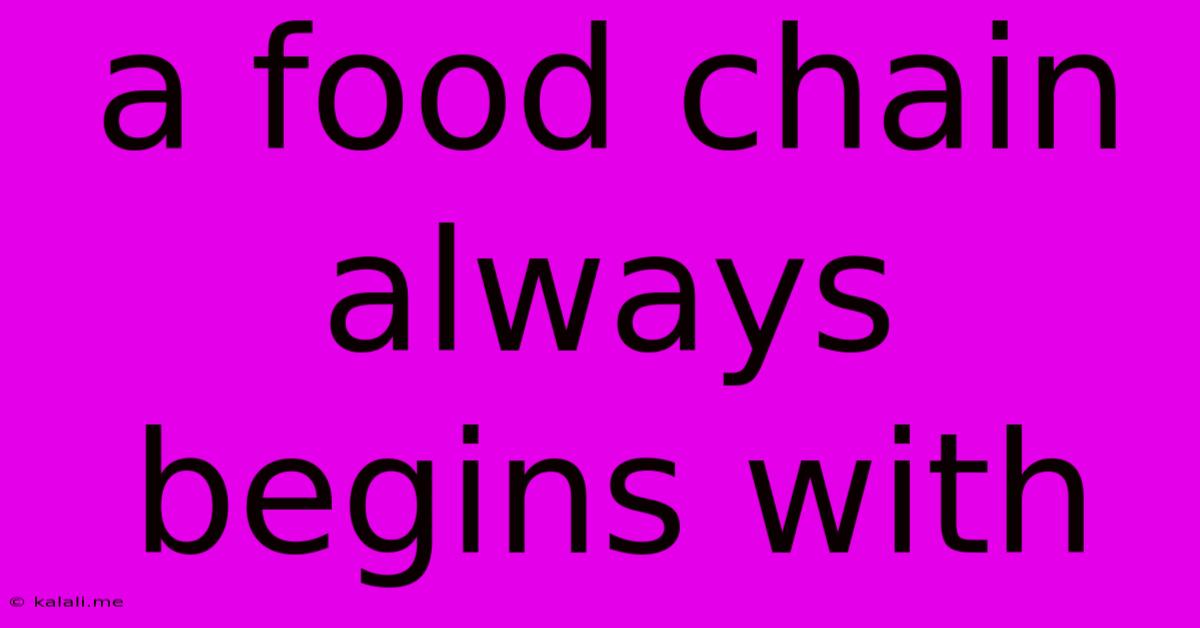A Food Chain Always Begins With
Kalali
Jun 15, 2025 · 3 min read

Table of Contents
A Food Chain Always Begins With: Producers and the Foundation of Life
A food chain is a linear network of links in a food web starting from producer organisms and ending at apex predator species, detritivores, or decomposer species. Understanding how a food chain functions is crucial to grasping the intricate balance of ecosystems. This article will explore the fundamental building block of every food chain: producers, and delve into why they're the essential starting point for all life within an ecosystem.
A food chain always begins with producers, also known as autotrophs. These are organisms that can produce their own food using energy from the sun or other inorganic sources. Unlike consumers (heterotrophs), which obtain energy by consuming other organisms, producers are self-sufficient, forming the base of the entire food web. This ability to convert light energy into chemical energy through processes like photosynthesis is the cornerstone of most ecosystems.
The Role of Photosynthesis and Chemosynthesis
The most common type of producer utilizes photosynthesis. This vital process involves capturing sunlight's energy to convert carbon dioxide and water into glucose (a sugar) and oxygen. Plants, algae, and certain bacteria are prime examples of photosynthetic producers. They form the foundation of terrestrial and aquatic food chains alike, providing the primary source of energy for countless other organisms.
In environments devoid of sunlight, such as deep-sea hydrothermal vents, chemosynthesis takes over. Chemosynthetic producers use chemical energy from inorganic compounds, such as hydrogen sulfide, to create organic molecules. These unique producers support entire ecosystems in these extreme environments, demonstrating the adaptability and importance of producers in diverse habitats.
Producers and the Transfer of Energy
The energy produced by producers isn't just stored; it's transferred throughout the food chain. When herbivores (primary consumers) consume plants, they obtain the stored energy in the form of glucose. This energy is then passed on to carnivores (secondary and tertiary consumers) when they prey on herbivores. The transfer of energy is not entirely efficient; some energy is lost as heat at each trophic level. This explains why food chains are usually limited in length – the energy available diminishes with each successive level.
Examples of Producers in Different Ecosystems
The types of producers found vary widely depending on the ecosystem. Let’s look at some examples:
- Forests: Trees, shrubs, and other plants are the dominant producers, supporting a diverse array of herbivores like deer and insects.
- Grasslands: Grasses, herbs, and wildflowers are the primary producers, providing sustenance for grazing animals like zebras and bison.
- Oceans: Phytoplankton (microscopic algae) are the most important producers, forming the base of marine food webs and supporting vast populations of zooplankton and fish.
- Coral Reefs: Coral polyps, in symbiosis with zooxanthellae (photosynthetic algae), act as producers, creating the foundation for this incredibly biodiverse ecosystem.
In conclusion, understanding that a food chain always begins with producers is paramount to understanding ecological dynamics. These self-sufficient organisms, whether photosynthetic or chemosynthetic, are the bedrock of life on Earth, driving energy flow and sustaining biodiversity across all ecosystems. Their importance cannot be overstated; without producers, the entire food web would collapse.
Latest Posts
Latest Posts
-
Who Created The First Psychology Laboratory
Jun 15, 2025
-
Which Type Of Fracture Is Associated With Intergranular Crack Propagation
Jun 15, 2025
-
How To Print Out Sat Admission Ticket
Jun 15, 2025
-
A Test That Measures A Students Potential Ability Is
Jun 15, 2025
-
Pingali Venkayya Born In Which State
Jun 15, 2025
Related Post
Thank you for visiting our website which covers about A Food Chain Always Begins With . We hope the information provided has been useful to you. Feel free to contact us if you have any questions or need further assistance. See you next time and don't miss to bookmark.